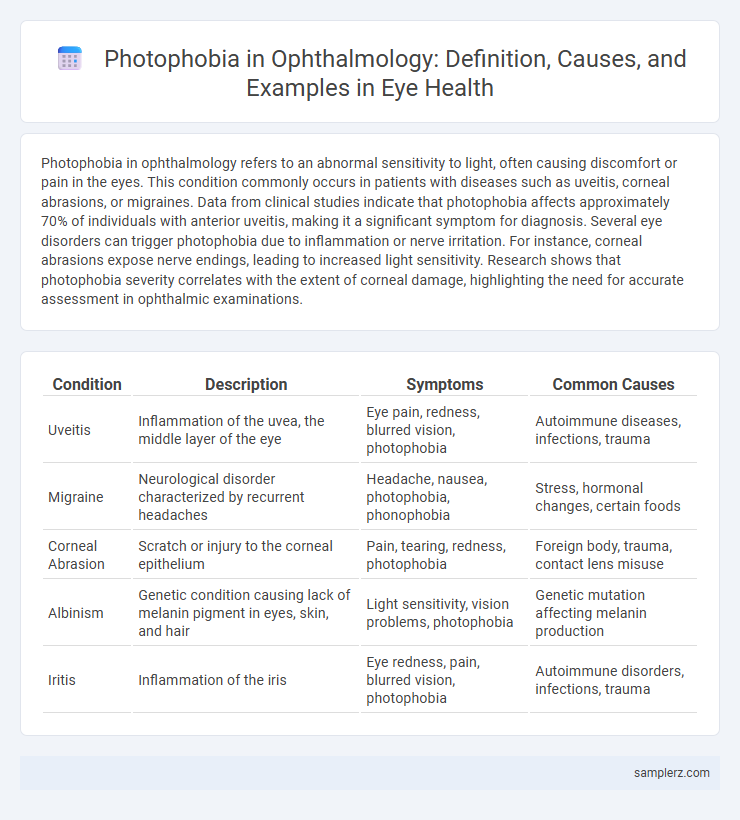Photophobia in ophthalmology refers to an abnormal sensitivity to light, often causing discomfort or pain in the eyes. This condition commonly occurs in patients with diseases such as uveitis, corneal abrasions, or migraines. Data from clinical studies indicate that photophobia affects approximately 70% of individuals with anterior uveitis, making it a significant symptom for diagnosis. Several eye disorders can trigger photophobia due to inflammation or nerve irritation. For instance, corneal abrasions expose nerve endings, leading to increased light sensitivity. Research shows that photophobia severity correlates with the extent of corneal damage, highlighting the need for accurate assessment in ophthalmic examinations.
Table of Comparison
| Condition | Description | Symptoms | Common Causes |
|---|---|---|---|
| Uveitis | Inflammation of the uvea, the middle layer of the eye | Eye pain, redness, blurred vision, photophobia | Autoimmune diseases, infections, trauma |
| Migraine | Neurological disorder characterized by recurrent headaches | Headache, nausea, photophobia, phonophobia | Stress, hormonal changes, certain foods |
| Corneal Abrasion | Scratch or injury to the corneal epithelium | Pain, tearing, redness, photophobia | Foreign body, trauma, contact lens misuse |
| Albinism | Genetic condition causing lack of melanin pigment in eyes, skin, and hair | Light sensitivity, vision problems, photophobia | Genetic mutation affecting melanin production |
| Iritis | Inflammation of the iris | Eye redness, pain, blurred vision, photophobia | Autoimmune disorders, infections, trauma |
Common Causes of Photophobia in Ophthalmology
Photophobia in ophthalmology is commonly caused by conditions such as corneal abrasions, uveitis, and conjunctivitis, which lead to increased light sensitivity due to inflammation or injury to the eye structures. Migraines and optic neuritis also frequently induce photophobia by affecting the neural pathways responsible for light perception. Identifying the underlying cause through clinical examination and patient history is essential for effective treatment and symptom management.
Clinical Manifestations of Photophobia
Photophobia in ophthalmology commonly manifests as eye discomfort or pain when exposed to bright light, excessive tearing, and involuntary squinting. Patients frequently report headaches, blurred vision, and increased sensitivity that worsens in bright environments. These clinical signs are often associated with underlying conditions such as uveitis, corneal abrasions, or migraine-related ocular disturbances.
Photophobia in Corneal Disorders
Photophobia commonly manifests in corneal disorders such as keratitis, corneal abrasions, and keratoconus, causing heightened light sensitivity and ocular discomfort. These conditions lead to inflammation or structural damage of the cornea, triggering pain and reflexive eyelid closure when exposed to light. Effective management involves treating the underlying corneal pathology alongside using protective eyewear to minimize photic irritation.
Uveitis and Associated Light Sensitivity
Photophobia is a common symptom in ophthalmology, particularly associated with uveitis, an inflammation of the uveal tract including the iris, ciliary body, and choroid. Patients with uveitis often experience intense light sensitivity due to disruption of the blood-ocular barrier and inflammatory mediators irritating ocular structures. Effective management of uveitis-related photophobia involves controlling inflammation using corticosteroids and immunosuppressive agents to alleviate discomfort and prevent vision complications.
Photophobia in Migraine-Related Eye Conditions
Photophobia in migraine-related eye conditions commonly manifests as extreme light sensitivity during migraine attacks, often exacerbating visual discomfort and pain. Neurological pathways involved include trigeminal nerve activation and cortical spreading depression, which amplify retinal and brain light sensitivity. Effective management may involve using tinted lenses, controlling migraine triggers, and pharmacological treatments targeting both migraine and photophobia symptoms.
Diagnosing Photophobia: Key Ophthalmic Tests
Diagnosing photophobia involves key ophthalmic tests such as slit-lamp examination to detect corneal abnormalities, pupillary light reflex assessment for neurological evaluation, and fundoscopy to identify retinal or optic nerve disorders. Visual evoked potentials (VEP) and electroretinography (ERG) further assist in assessing optic pathway integrity and retinal function. Accurate diagnosis requires combining clinical findings with patient symptom history to tailor effective treatment strategies.
Role of Ocular Surface Disease in Photophobia
Ocular surface disease, including dry eye syndrome and blepharitis, significantly contributes to photophobia by disrupting the corneal epithelium and triggering inflammation. This inflammation activates corneal nerve endings, intensifying light sensitivity and causing discomfort in bright environments. Effective management of ocular surface disease can reduce photophobic symptoms and improve patient quality of life.
Managing Photophobia: Ophthalmological Approaches
Managing photophobia in ophthalmology involves using tinted lenses or sunglasses that filter blue light to reduce retinal overstimulation. Pharmacological treatments such as cycloplegic eye drops help by minimizing pupillary light reflex and alleviating discomfort. In severe cases, addressing underlying conditions like uveitis or corneal abrasions is essential for effective photophobia management.
Pediatric Photophobia: Unique Considerations
Pediatric photophobia often presents in conditions such as albinism, anterior uveitis, and congenital aniridia, where light sensitivity significantly impacts visual comfort and development. Children with photophobia may exhibit behaviors like eye rubbing, squinting, and avoidance of bright environments, which can affect learning and social interactions. Early diagnosis and tailored management, including tinted lenses and environmental modifications, are crucial to improving quality of life for pediatric patients.
Photophobia as a Symptom of Systemic Diseases
Photophobia often presents in ophthalmology as a symptom linked to systemic diseases such as meningitis, Lyme disease, and autoimmune disorders like lupus. This sensitivity to light can indicate underlying neurological inflammation or systemic infection affecting ocular function. Proper diagnosis involves evaluating photophobia alongside other systemic signs to address the root cause effectively.

example of photophobia in ophthalmology Infographic
 samplerz.com
samplerz.com